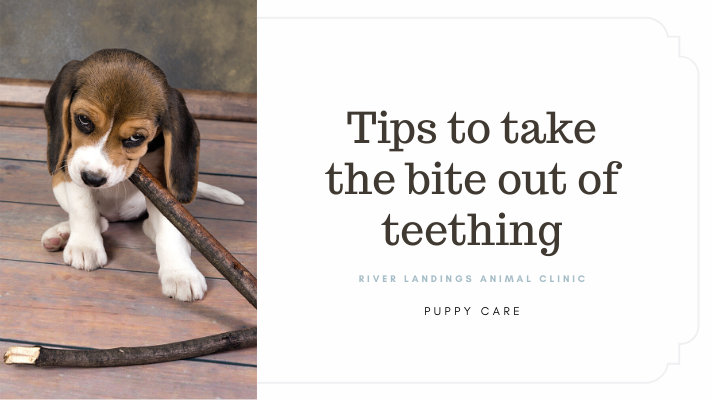5 Ways to Help with Puppy Teething
Next to potty training, the puppy teething phase is one of the most challenging periods of puppyhood. A puppy’s drive to nibble, chew, and bite can lead to a household full of destruction and bruised body parts. The puppy teething phase is a normal developmental period that occurs as a puppy’s adult teeth begin to replace the needle-sharp deciduous teeth. Depending on your dog’s breed and size, this can start to happen at about four or five months of age. Keep in mind that puppy biting isn’t caused by teething alone! Puppies also communicate and explore the world with their mouths, and it’s up to you to help your new puppy select what is and is not okay to chew.
1. Puppy Proof Your Home
You should puppy proof your home in anticipation of your puppy’s increased need to chew. Pick up anything on the ground that could be a teething target. That includes obvious items like shoes, socks, and low garbage bins, as well as things that might not be as obvious at first glance, like rugs with fringe on the end, decorative baskets, magazine racks, and semi-hidden cords. The desperate-to-chew puppy might zero in table legs, chair/sofa legs, and cabinetry, so consider treating them with a bitter chew deterrent spray. If your puppy picks up an item that they aren't supposed to have, offer them a trade with one of their special toys or a treat.
2. Teach Your Puppy ‘Gentle Mouth’
Puppies quickly learn that they get a reaction when they bite, whether it’s from their littermates or from their human caregivers. It hurts! Teaching your new puppy the importance of a gentle mouth is an important lesson. When your puppy clamps down on your hand too hard, mark the painful infraction by saying “Ouch!” and pull your hand away. Withdraw your attention for a few moments, and then resume contact with your dog. If your puppy bites down too hard again, mark the bite by saying “ouch” again, but this time get up and walk away from your dog, leaving them alone. This is social isolation, a potent but gentle punishment. If your timing is good, your puppy will soon learn that biting too hard makes their favorite person leave.
3. Provide Appropriate Chewing Outlets
Puppies need to have a variety of appropriate chewing outlets. Although plush dog toys are cute, they don’t last long enough to provide the teething puppy the type of resistance their sore gums require. Hard rubber dog toys are ideal, particularly the kind that have spots for treat stuffing. Some toys have small holes that require the puppy to move the toy around to get the goodies out, while others have larger holes that encourage the puppy to hold on to the toy and gnaw and lick to get the treats.
4. Try Frozen Goodies
Frozen goodies can also help a teething puppy. You can fill your puppy’s hard rubber toys with peanut butter and freeze them, or invest in a teething toy that can be wet like a sponge and frozen. A low-cost alternative is to wet and freeze a washcloth, but make sure to take it away once it’s thawed so your dog doesn’t rip it apart. Finally, try giving your teething puppy a frozen carrot for a healthy way to relieve some of the pain.
5. Buy Quality Dog Food
Make sure to feed your puppy a balanced diet that supports controlled growth and dental health. Quality dog foods that contain a whole named protein, like chicken, and have a mix of vitamins and minerals, including calcium for strong bones and teeth, will help your puppy’s smile look good for a lifetime. Ask your veterinarian about what is best for your dog!
Remain Patient
Puppy teething is a rite of passage that all puppy parents must endure, but with the right equipment and attitude, it can be a lot less painful!
Hear From Us Again
Don't forget to subscribe to our email newsletter for more recipes, articles, and clinic updates delivered to your inbox (here). Or, you can keep up to date by liking and following our Facebook page (here).
Related: We have more information under our dog health category.


